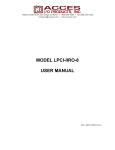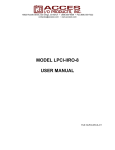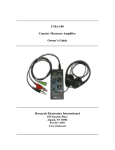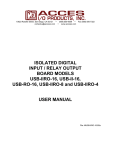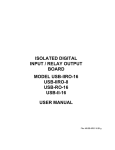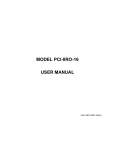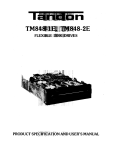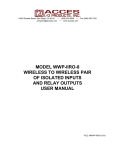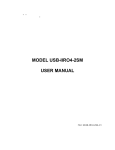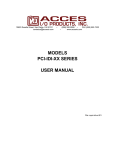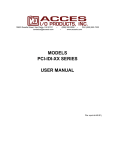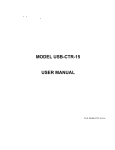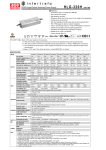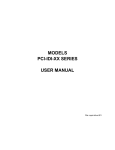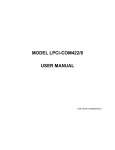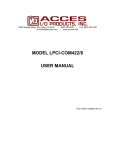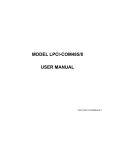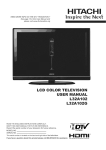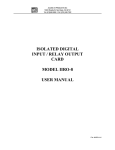Download MODEL LPCI-IIRO-8 USER MANUAL
Transcript
C C C MODEL LPCI-IIRO-8 USER MANUAL FILE: MLPCI-IIRO-8.A1e Notice The information in th is do cument is provided for reference only. Portwell does not assume any liability arising out of the a pplica tion or u se of the informa tion or p rodu cts described herein. This document may contain or reference information and prod ucts protected by co pyrigh ts or patents and does not convey any license under the patent rights of Portwell, nor the rights of others. IBM PC, PC/XT , and PC/AT are registered trademarks of the International Business Machines Corporation. Printed in USA. Copyright 2006 by Portwell I/O Products Inc. All rights reserved. WARNING!! ALWAYS CONNECT AND DISCONNECT YOUR FIELD CABLING WITH THE COMPUTER POWER OFF. ALWAYS TURN COMPUTER POW ER OFF BEFORE INSTALLING A CARD. CONNECTING AND DISCONNECTING CABLES, OR INSTALLING CARDS INTO A SYSTEM WITH THE COMPUTER OR FIELD POWER ON MAY CAUSE DAMAGE TO THE I/O CARD AND WILL VOID ALL WARRANTIES, IMPLIED OR EXPRESSED. 2 Ma nual LP CI-IIRO -8 Warranty Prior to shipment, Portwell equipm ent is thoroughly inspected and tested to applicable specifications. How ever, sho uld equipment failure occu r, Portwell assu res its cu stomers that prompt se rvice and sup port will be available. All equipment originally manufactured by Portwell which is found to be defective will be repaired or replaced subject to the following considerations. Terms and Conditions If a unit is suspected of failure, contact Portwell' Customer Service departm ent. Be prepared to giv e the unit model number, serial num ber, and a description of the failure symptom(s). W e m ay suggest so me sim ple tests to confirm the failure. We will assign a Return Material Authorization (RMA) number which must appear on the outer label of the return package. All units/components should be properly packed for handling and returned with freight prepaid to the Portwell designated Service Center, and will be returned to the customer's/user's site freight prepaid and invoiced. Coverage First Thre e Years : Retu rned unit/pa rt will be re paired an d/or replaced at Portwell option with no charge for labor or parts not excluded by w arran ty. Warran ty com me nce s with equ ipm ent shipm ent. Following Years: Throughout you r equipment's lifetime, Portwell sta nds read y to provide on-site or in-plant service at reasonable rates similar to those of other manu facturers in the industry. Equipment Not Manufactured by Portwell Equipment provided but no t man ufactured by Portwell is wa rranted and w ill be repaired according to the terms and c onditions of the respective equipme nt manu facturer's warranty. General Under this Warranty, liability of Portwell is limited to replacing, repairing or issuing credit (at Portwell discretion) for any p roducts w hich are proved to be defective during the wa rran ty pe riod. In no cas e isPortwell liable for consequential or special damage arriving from use or misuse of our product. The customer is resp onsible for all cha rges ca used by m odifications or additions to Portwell equ ipm ent not approved in writing by Portwell or, if in Portwell opinion the equ ipm ent has been subjected to abnorm al use . "Abnormal use" for purposes of this warranty is defined as any use to w hich the equipment is exposed other than that use specified or intended as evidenced by purchase or sales representation. Other than the above, no other warranty, expressed or implied, shall apply to any and all such equipment furnished or sold by Portwell. 3 Ma nual LP CI-IIRO -8 TABLE OF CONTENTS Chapter 1: Introduction . . . . . . . . . . . . . . . . . . . . . . . . . . . . . . . . . . . . . . . . . . . . . . . . . . . . . . . . . . . . . . . . 5 Figure 1-1: Block Diagram . . . . . . . . . . . . . . . . . . . . . . . . . . . . . . . . . . . . . . . . . . . . . . . . 8 Chapter 2: Installation . . . . . . . . . . . . . . . . . . . . . . . . . . . . . . . . . . . . . . . . . . . . . . . . . . . . . . . . . . . . . . . . 9 Chapter 3: Option Selection . . . . . . . . . . . . . . . . . . . . . . . . . . . . . . . . . . . . . . . . . . . . . . . . . . . . . . . . . . . 11 Figure 3-1: Option Selection Map . . . . . . . . . . . . . . . . . . . . . . . . . . . . . . . . . . . . . . . . . . 11 Chapter 4: Address Selection . . . . . . . . . . . . . . . . . . . . . . . . . . . . . . . . . . . . . . . . . . . . . . . . . . . . . . . . . . 12 Chapter 5: Programming . . . . . . . . . . . . . . . . . . . . . . . . . . . . . . . . . . . . . . . . . . . . . . . . . . . . . . . . . . . . . 13 Ch apte r 6: Co nne ctor P in As signme nts . . . . . . . . . . . . . . . . . . . . . . . . . . . . . . . . . . . . . . . . . . . . . . . . . . 14 Tab le 6-1: Conne ctor P in As signme nts . . . . . . . . . . . . . . . . . . . . . . . . . . . . . . . . . . . . . 14 4 Ma nual LP CI-IIRO -8 Chapter 1: Introduction The LPCI-IIRO-8 is a Low-Profile PCI bus compatible card that provides isolated digital input and output interface for PCI-Bus computers. The card has eight optica lly-isolated digital inputs for AC or DC control signals and eight electromechanical relay outputs. LPCI-IIRO-8 occupies four consecutive 8-bit registers in I/O space. Features: • • 8 optically-isolated, non-polarized CMOS compatible digital inputs accept +/-31volts DC or AC rms 8 form C electro-mechanical relays switch up to 1 A each Inputs The LPCI-IIR O-8 provides eight optica lly-isolated inputs. These inputs can accept either A C o r DC sign als and are not polarity sen sitive . Input sig nals are rectified by photo cou pler diodes while un use d po we r gets dissipated thru a 1.8k-ohm resistor in series. The inputs may be driven by either DC sources of 3 to 3 1 volts (rms) or AC sources at frequ enc ies of 4 0 Hz to 10 KH z. Standard 12/24 AC control transformer outputs can be acc epted as w ell. External resistors connected in series may be used to extend the input voltage range, however this will raise the input threshold range. Consult with factory for available modified input ranges. Each input circuit contains a switchable filter that has a 4.7 millisecond time constant. (Without filtering, the response is less then 4 0 microseco nds) Th e filter must be selected for AC inputs in order to eliminate the on/o ff respons e to A C. The filter is also valuable for use with slow DC input signals in a noisy environm ent. The filter may be switched out for D C in puts in order to obtain faster response. Filters are individually selected by jumpers. The filters are switched into the circuit when the jumpers are installed in position FLT0 to FLT15. Ou tputs The board’s outputs are com prised of eight FOR M C SPD T electro mech anical relays. These relays are all de-e nerg ized at powe r-on. 5 Ma nual LP CI-IIRO -8 Specification Isolated Inputs Num ber of inputs: Eight Type: Non-polarized, optically isolated from each other and from the com puter (CMO S compatible) Voltage Range: 3 to 31 DC or AC R ms (40 to 10000 Hz) Isolation: 500V*(see note) channel-to-ground or channel-to channel Inpu t Resistan ce: 1.8K ohms in series with opto coupler Filter Response Times: Rise Time = 4.7 mS / Fall Time = 4.7 mS Non-Filter Response Times: Rise Time = 10 uS / *Notes on Isolation: Op to-Isolato rs and connectors are rated for at least 500V, but isolation voltage breakdowns will vary and is affected by factors like cabling, spacing of pins, spacing between traces on the PCB, hum idity, dust and other environmental factors. This is a sa fety issue so a careful approach is required. For CE certification, isolation was specified at 40V AC and 60V DC. The design intention wa s to e liminate the influence of common m ode. Use proper wirin g techniques to m inim ize voltage between channels and to ground. For example, when working with AC voltages do not connect the hot side of the line to an input. Tolerance of higher isolation voltage can be obtained on request by applying a con form al coa ting to the bo ard. Fall Time = 30 uS Rela y Ou tputs Num ber of outputs: Eight SPDT form C Contact Type: Single crossbar; Ag with Au clad Rated Load AC: 0.5 A at 125 VAC (62.5 V A m ax.) Rated Load DC: 1A at 24 VD C (30 W ma x.) Max. Switching Voltage: 125 VAC, 60 VDC Ma x. Sw itching Current: 1A Contact Resistance: 100 m S max. Co ntact Life : mech'l: 5 million operations min. Operating Time: 5 milliseconds max. Release Time: 5 milliseconds max. Power Required: 30 mA typical per Relay Energized En viron menta l: Op erating Te mp : 0 - 70 oC (Non-icing) W eight: 2.85 oz 6 Ma nual LP CI-IIRO -8 Figure 1-1: Block Diagram 7 Ma nual LP CI-IIRO -8 Chapter 2: Installation A printed Qu ick-S tart Guide (QS G) is packed with the card for yo ur conve nience. If you’ve already performed the steps from the QSG, you may find this chapter to be redundant and may skip forward to begin developing your app lication. The software provide d with this ca rd is on CD and must be installed onto your hard disk prior to use. To do this, perform the following steps as appropriate for your operating system. Configure Card Options via Jumper Selection Before installing the card into your computer, carefully read Chapter 3: Option Selection of this manual, then configure the card acco rding to you r requirem ents. O ur W indow s ba sed se tup program can be use d in conjunction with Chapter 3 to assist in configuring jumpers on the card, as well as provide additional descriptions for usage of the various card options. CD Software Installation The following instructions assume the CD-RO M drive is drive “D”. Please substitute the appropriate drive letter for your system as necessa ry. DOS 1. Place the CD into your CD-ROM drive. 2. Type d:K to change the active drive to the CD-ROM drive. 3. 4. Type installK to run the install program. Follow the on-screen prompts to install the software for this board. W IN DO W S 1. Place the CD into your CD-ROM drive. 2. The system sho uld autom atically ru n the ins tall prog ram . If the install program d oes not run prom ptly, 3. click START | RUN and type d:install, click OK or press K . Follow the on-screen prompts to install the software for this board. LINUX 1. Plea se refer to linux.htm on the CD-R OM for inform ation on ins talling unde r linux. Caution! * ESD A single static discharge can damage your card and cause p rem ature failure! Please follow all reason able precau tions to preve nt a s tatic discharge such as grounding yourself by touching any grounded surface prior to touching the card. 8 Ma nual LP CI-IIRO -8 Hardware Installation 1. 2. 3. 4. 5. 6. 7. 8. 9. 10. Make sure to set switches and jumpers from either the Option Selection section of this manual or from the suggestions of SETUP.EXE. Do not install card into the computer until the software has been fully installed. Turn OFF computer power AND unplug AC power from the system. Rem ove the com puter co ver. Ca refully insta ll the card in an available 5V or 3.3V PCI expansion slot (you may need to remove a back plate first). Inspect for proper fit of the card and tighten screw s. M ake su re that the ca rd m ounting bracket is properly screwed into place and that there is a positive chassis ground. Install an I/O ca ble onto the card’s b racket m ounted con nector. Replace the computer cover and turn ON the computer which should auto-detect the card (depending on the operating system) and automatically finish installing the drivers. Run PC Ifind.exe to co mp lete installing the card into the registry (for Windows only) and to determine the assigned resources. Run one of the provided sample programs that was copied to the newly created card directory (from the CD) to test and validate your installation. The base address assigned by BIOS or the operating system can change each time new hardw are is installed into or removed from the computer. Please recheck PCIFind or Device Manager if the hardw are configuration is changed. Software you write can automatically determine the base address of the card using a variety of methods depending on the operating system. In DOS, the PCI\SOURCE directory shows the BIOS calls used to determine the address and IRQ assigned to installed PCI devices. In Windows, the Windows sample programs demonstrate querying the registry entries (created by PCIFind and NTIOPCI.SYS during boot-up) to determine this same information. 9 Ma nual LP CI-IIRO -8 Chapter 3: Option Selection The only user configurable option available w ith this ca rd are the inp ut filters. If you install a jumper shorting block at any of the FLT0 through FLT7 jumper positions, that input channel (0-7, respectively) will have a filter applied. With the jumper shorting block removed the filter is also removed. Figure 3-1: Option Selection Map 10 Ma nual LP CI-IIRO -8 Chapter 4: Address Selection This card uses I/O addresses offset from the base address assigned by the PCI bus. The address spa ces are defined in th e Program ming sec tion of this m anual. PCI architecture is Plug-and-Play. This means that the BIOS or Operating System determines the resources assigned to PCI cards rather than the user selec ting the se resou rces with switch es or jumpers . As a result, you cannot set or change the card’s base address or IRQ level. You can only determine what the system has assigned. To determine the base address that has been assigned, run the PCIFind utility program. This utility will display a list of a ll the cards detected on the PCI bus, the addresses assigned to each function on each of the cards, and the respe ctive IR Qs . Alternatively, Windows systems can be queried to determine which resources were assigned. In these operating system s, you ca n use either PC IFind, or the D evice M anag er utility from the Sys tem P roperties applet of the contro l pan el. The card is installed in the D ata A cqu isition cla ss of the D evice Ma nag er list. Selecting the card, clicking Properties, and then selecting the Resources Tab will display a list of the resources allocated to the card. The PCI bus supports 64K of I/O address space, so your card’s addresses may be located anywhere in the 0000h to FFFFh range. The card occupies eight consecutive 8 bit registers in the I/O address space. PCIFind uses the Vendor ID and Device ID to search for your card, then read s the base ad dres s and IRQ. If you want to determine the base address and IRQ without using PCIFind, use the following information: The Ven dor ID code is 494F (ASC II for “I/O”) The Device ID code for the card is 0F01 An example of how to locate PCI card resources is provided in the PCI/SOURCE directory, under your installation directory. This code runs in DOC , and uses the PCI defined interrupt BIOS calls to query the PCI bus for card-specific information. You will need the Device ID and Vendor ID listed above to use this code. 11 Ma nual LP CI-IIRO -8 Chapter 5: Programming The base or starting address is assigned by the computer system during installation and will fall on a fou r bit boundary. LPCI-IIRO-8 read and write functions as follows: I/O Address Read Write Base +0 Read Relay Output Write Relay Output Base +1 Re ad Isolated Inputs Clear Interrupt Base +2 Enable IRQ Disable IRQ Base +3 IRQ Status Unused Digital Inputs Digital input states are read a s a sin gle byte from the port at Base Address + 1. Each of the eigh t bits w ithin the byte c orres pon ds to a particular digital inpu t. A "1" signifies that the input is energized and a "0" signifies that the input is de-energized. Bit Position D7 D6 D5 D4 D3 D2 D1 D0 Digital Input IP7 IP6 IP5 IP4 IP3 IP2 IP1 IP0 The card supports interrup ts on change of state of digital inputs. Thus, it is not nece ssary to con tinuously poll inputs (by reading at base address +1) to detect any state change. To enable this interrupt capability, read at base address +2. To disable interrupts, write at base address +2. To clear an IRQ, write at base address +1. Relay Outputs At power-up, all relays are de-energized. The current state of the relays can be determined at any time by a read ope ration at the b ase add ress. The relay o utpu ts are controlled b y writing to the base ad dres s. Da ta are written to all eight relays as a single byte. E ach bit within the b yte co ntrols a specific relay. A "1" ene rgizes the correspo nding relay and a "0 " turns it off. Bit Position D7 Re lay C ontr'd OP7 D6 D5 D4 D3 OP6 OP5 OP4 OP3 D2 D1 OP2 OP1 D0 OP0 For exam ple, if bit D5 is turn ed o n by writing hex 20 to the base add ress the relay tha t controls OP5 is energized (closing the associated normally-o pen co ntacts). All other relays w ould be de-energized and their normally-closed contacts would be closed. 12 Ma nual LP CI-IIRO -8 Base+3 IRQ Status Bit Position D7 D6 D5 D4 D3 Function D2 D1 D0 IRQ En able IRQ Occurred Reading Base+3 provides status bits associated with IRQ operations. Bit 0: a high b it indicates an IR Q ha s occu rred since you last read this register. Bit 1: a high b it indicates the IR Qs a re enabled (by w riting to base+ 2). 13 Ma nual LP CI-IIRO -8 Chapter 6: Connector Pin Assignments Pin # S ig na l N am e Pin # S ignal N am e 1 Ground 23 Relay 7 NO 2 Input 7 B 24 Relay 6 NO 3 Input 5 A 25 Relay 5 NO 4 Input 4 B 26 Relay 4 NO 5 Input 2 A 27 Relay 3 NO 6 Input 1 B 28 Relay 2 NO 7 No Con nect 29 Relay 1 NO 8 Relay 7 Comm on 30 Relay 0 NO 9 Relay 6 Comm on 31 Input 7 A 10 Relay 5 Comm on 32 Input 6 B 11 Relay 4 Comm on 33 Input 4 A 12 Relay 3 Comm on 34 Input 3 B 13 Relay 2 Comm on 35 Input 1 A 14 Relay 1 Comm on 36 Input 0 B 15 Relay 0 Comm on 37 Relay 7 NC 16 No Con nect 38 Relay 6 NC 17 Input 6 A 39 Relay 5 NC 18 Input 5 B 40 Relay 4 NC 19 Input 3 A 41 Relay 3 NC 20 Input 2 B 42 Relay 2 NC 21 Input 0 A 43 Relay 1 NC 22 No Con nect 44 Relay 0 NC Tab le 6-1: Conne ctor P in As signme nts 14 Ma nual LP CI-IIRO -8 Customer Comments If you experience any problems with this manual or just want to give us som e feedback, p lease em ail us at: t ech @p o rt we ll.c o m . Please detail any errors you find and include your mailing address so that we can send you any manual updates. 15 Ma nual LP CI-IIRO -8















